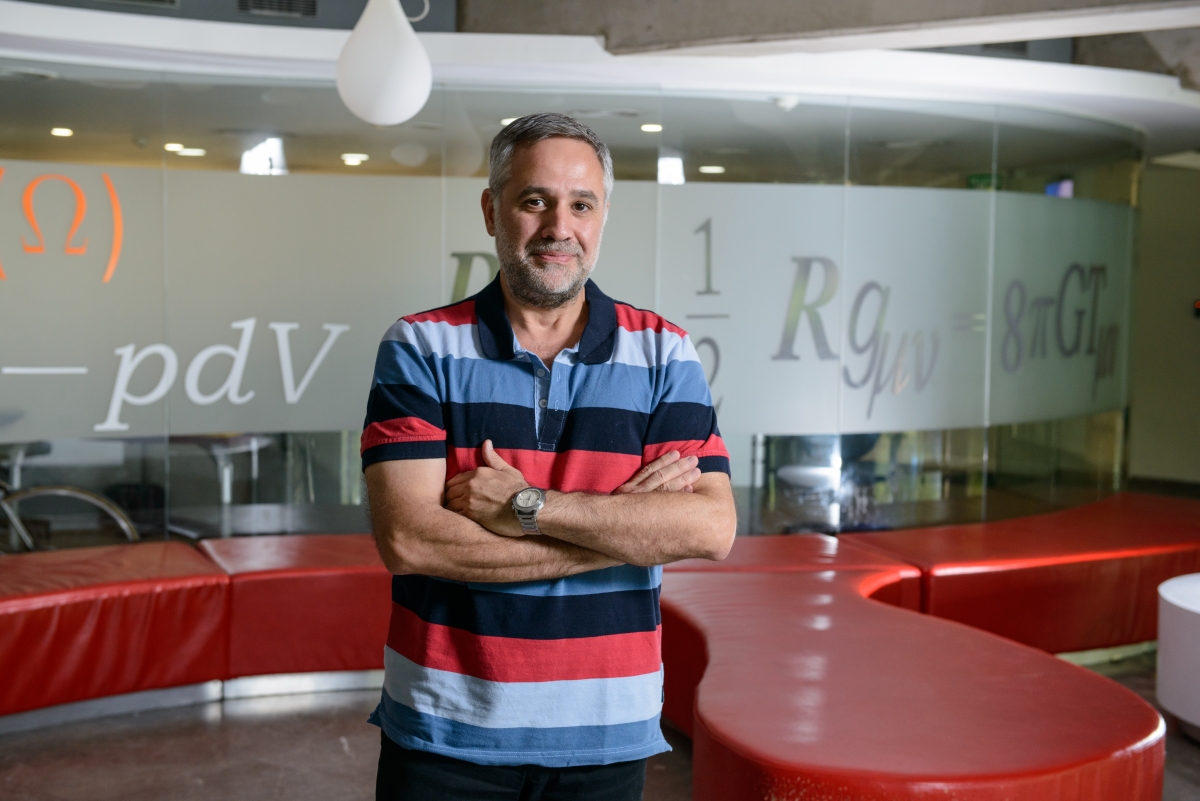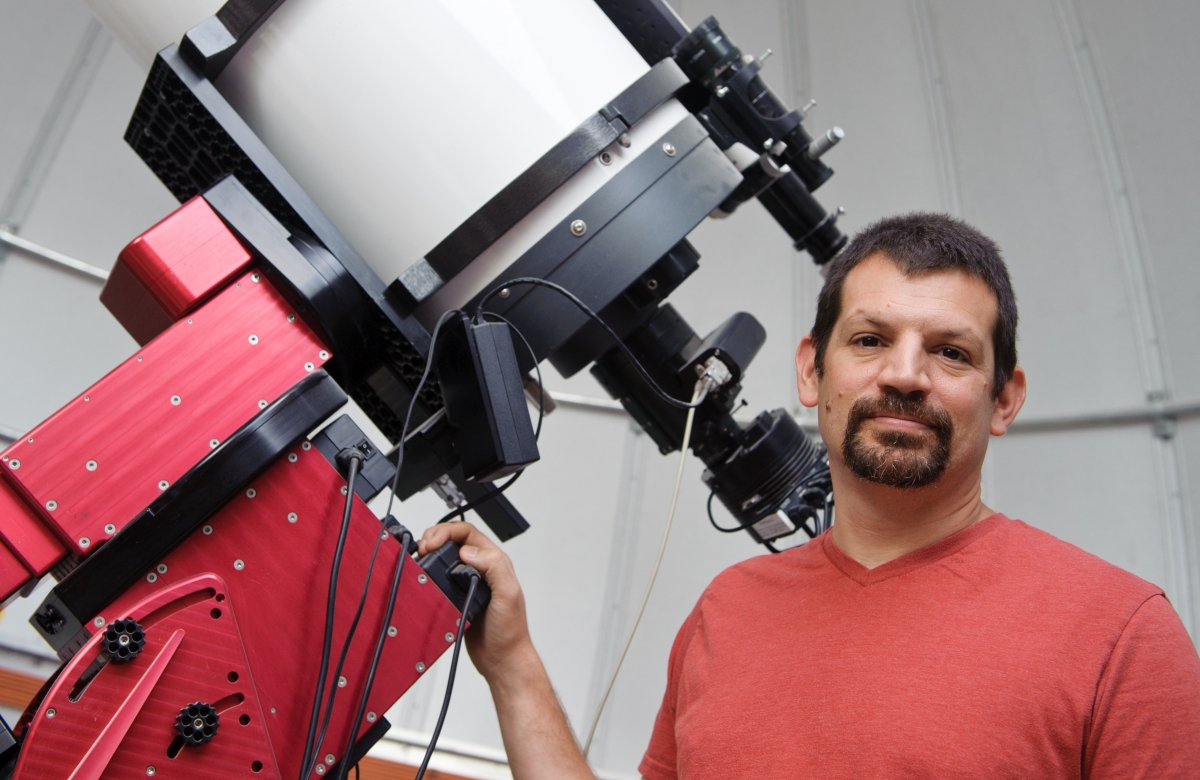Eyes on the sky
ULTRASAT will shed light on the cosmos
Features

When massive objects move through the cosmos, they cause ripples in space-time—the fabric of the universe. These ripples, called gravitational waves, were predicted by Albert Einstein in 1916, based on his theory of general relativity. A century later, Einstein’s prediction was confirmed when scientists at LIGO—an observatory in which two widely separated detectors, one in Louisiana, and the other in Washington State—finally detected a gravitational wave produced when two black holes merged. The “chirp” that announced the wave’s arrival was one of an uncountable number of similar messages that may have washed over our planet since the dawn of time.
It lasted just seven milliseconds, and the signal disappeared.
LIGO’s achievement illustrates a problem with studying the sky: we can’t keep our eyes on everything all at once. Weizmann Institute scientists are planning to solve this problem with ULTRASAT—a new satellite that will make it possible to continuously gather data on transient events, like gravitational waves, to clue us in to the dynamics of our ever-changing universe. ULTRASAT, an acronym for “Ultraviolet Transient Astronomy Satellite,” operates by detecting and measuring UV radiation emerging from deep space—transient signals that are remnants of cataclysmic cosmic events that occurred billions of years ago.

Prof. Eli Waxman
Galileo Galilei, the 16th century Italian astronomer known as the father of observational astronomy once wrote: “He who looks the higher is the more highly distinguished, and turning over the great book of nature (which is the proper object of philosophy) is the way to elevate one’s gaze.” With their powerful new platform for observing the celestial events that gave shape to the known universe—events that continue to influence life on Earth to the present day—the ULTRASAT team at the Weizmann Institute is making a distinguished contribution.
Nimble and prescient
Designed to do more with less, ULTRASAT is an affordable and relatively small satellite. According to its Weizmann creators, ULTRASAT will help hulking land-based observatories do their job better, by capturing transient event data over an unprecedentedly wide field of view, and broadcasting “coming attractions” reports that will help astronomers swing their telescopes over to where the action is.

Prof. Avishay Gal-Yam
“There are land-based observatories all around the world that do surveys of the night sky and try to catch signals related to short, transient events, like the flares accompanying the collisions of massive stars, that also lead to the emission of gravitational waves,” says Prof. Eli Waxman, the principal investigator (PI) who directs the ULTRASAT project. “But unless you’ve been focusing your lens in the right direction—something you’re unlikely to do because you never know when and where massive stars are going to collide—you will be missing the flare altogether. Our approach is different: when launched into orbit, ULTRASAT will observe and record cosmic events that we don’t know about in advance, then alert the observatories on the ground almost immediately, so scientific teams all over the world will be able to focus in, and follow events as they unfold.”
ULTRASAT represents a revolutionary step forward for the astrophysics community, because it is capable of detecting and measuring the ultraviolet emissions from transient explosions minutes after they occur—not the days or weeks required by current telescopic systems. Continuously gathering this data in six-month increments, ULTRASAT is expected to generate a “discovery rate”—the rate at which celestial events are identified—that is 300 times greater than today’s technologies. “This will revolutionize our understanding of a wide range of explosive transient events, like the explosions of stars and the disruption of stars by massive black holes,” says Prof. Avishay Gal-Yam, deputy PI of the ULTRASAT mission.
High-flying collaborations
The timing of the ULTRASAT project is critical. The goal is to launch the satellite in time to take advantage of a planned international upgrade of the world’s array of Gravitational Wave Detectors, ground-based systems operating from both the US and Europe.
This race against time just got a boost from a recently announced partnership between the Weizmann Institute and the Helmholtz Association of German Research Centers, a consortium that supports the advancement of science in Germany, and is one of the most important frameworks for the support of scientific excellence worldwide.
The German Aerospace Center (DLR) is one of 19 member organizations of the Helmholtz Association, as is Deutsches Elektronen-Synchrotron (DESY), a national research center that carries out research in a wide range of experimental programs including particle physics and astrophysics. Weizmann Institute researchers have previously collaborated with DESY experts on the creation of advanced, land-based telescopes, a partnership that will now be even stronger, thanks to the ULTRASAT project.
“What excites me most when I visit institutions or labs is really smart people. And that’s why I enjoy being at Weizmann. If you want to cooperate, you must cooperate with the best,” says Prof. Otmar Wiestler, President of the Helmholtz Association, who recently visited the Weizmann Institute campus.
According to Prof. Waxman, the international ULTRASAT collaboration is expected to expand to additional partners. The European Space Agency (ESA), with whom the Israel Space Agency (ISA) has been hoping to collaborate for years, is interested in making a contribution, and discussions are underway to define the nature of this involvement.
Following the initiation of the WIS-DESY/Helmholtz collaboration in early July, and the advanced negotiations with ESA, the ISA and the Weizmann Institute agreed to start the full-scale ULTRASAT project in September 2019. The satellite will be built by Israel Aerospace Industries and Elbit Systems/Electron Opotics (Elop), while the data infrastructure and scientific operations center will be constructed and housed on the Weizmann Institute campus. The entire project will be jointly funded and managed by the Institute and the ISA.
“The study of transient phenomena will be a major focus of astrophysics research in the coming decade. ULTRASAT will lead this worldwide effort, with a small affordable satellite constructed under Israeli scientific Israeli leadership” says Prof. Waxman.
“In addition to providing a platform for astrophysics discovery, the mission—which we are embarking upon in collaboration with leading industrial partners and agencies—will strengthen the Israeli space industry’s leadership within the international community, he adds. It will also have an educational impact, inspiring young Israelis to pursue careers in science and technology. September 2019 marks the beginning of an exciting and challenging mission: to put ULTRASAT in space by 2023.”
Prof. Eli Waxman is supported by the Nella and Leon Benoziyo Center for Astrophysics and the Schwartz/Reisman Institute for Theoretical Physics. He is the incumbent of the Max Planck Professorial Chair of Quantum Physics.
Prof. Gal-Yam is supported by the Benoziyo Endowment Fund for the Advancement of Science, the André Deloro Institute for Advanced Research in Space and Optics, Paul and Tina Gardner, the Helen and Martin Kimmel Award for Innovative Investigation, the Veronika A. Rabl Physics Discretionary Fund, the Schwartz/Reisman Collaborative Science Program, and the European Research Council








